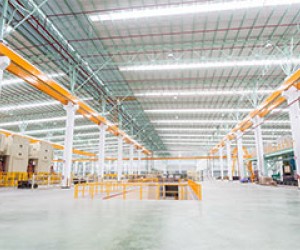11 Aug

343 View(s)
Considerations When Choosing Industrial Lighting
While choosing industrial lighting fixtures, the following points should be considered; Fixtures that meet the environmental conditions, comply with the requirements of the working and production conditions, take care of their beautiful appearance, and protect the principle of easy installation and coordination with the structure should be selected. With the decrease in the use of traditional lamps in industrial applications, LED lighting is becoming more and more popular and the product variety of industrial lighting fixtures in the market is increasing.
The performance of LED lamps is very different from conventional lamps, especially LED lights used in industrial lighting. Well, how to choose good and suitable LED lamps for industrial lighting when purchasing, let's take a look at them together;
-Industrial lighting should ensure the comfort and safety of employees, while ensuring that the lighting level of the entire floor area and the worktable surface reach a balance.
- Luminance is a measure of the power emitted by a light source in a given direction per unit solid angle per unit area. In other words, luminance is the amount of light that passes or emitted from a given area within a certain solid angle. The brightness of the LED lights is the problem that users are most concerned about.
Usually LED lights are marked with luminous flux, which allows the user to determine the brightness of an LED light. The higher the luminous flux, the brighter the LED lamp. Luster is a subjective quality and a physical property of light. Brightness is an important feature in industrial lighting fixtures.
Choosing a lamp with the right color quality ensures particularly good lighting levels. In addition, maintaining health and safety practices and keeping personnel at maximum efficiency is very important for large industrial buildings such as factories or warehouses.
-Leakage current is also called saturation current because it is quite independent of the amount of reverse bias. However, it is not independent of the carriers produced by other energy sources. If the diode is heated or illuminated, more carriers are released to contribute to increasing the reverse saturation current.
The LED is a unidirectional conductive light body. If there is a reverse current, it is called leakage. The leakage current has a great relationship with the lifetime of the lamps. No leakage current is ideal. Because leakage current cannot be one of the factors affecting the life of the lamp in this case. But if the leakage current is too large, the service life of the LED lamps will be short.
-There are many parameters that determine the quality of LED beads. One of the parameters is very important but can easily be overlooked. This important parameter is antistatic. That is, it is the resistance of LED lamp beads to static electricity. Because LED lamp beads are semiconductor devices sensitive to static electricity, it is very easy to cause electrostatic breakdown.
LED is the principle of electron flow to excite light, and static electricity has a great effect on electrons. Therefore, it cannot effectively resist static electricity, the light source cannot work normally, or even be put into use. Therefore, the antistatic property of the LED lamp bead is critical for the life of the LED industrial lighting fixture. The stronger the antistatic feature of the LEDs used in LED industrial lighting lamps, the longer the lamps' lifespan. Therefore, antistatic ability is also a very important reference parameter.
-The life of LED industrial lighting lamps is much longer than conventional lamps, but this does not mean that they will not fail. The performance of LED fixtures degrades over time with decreasing light levels. But the service life is an important parameter for evaluating the quality of industrial lamps. Longer service life means fewer lamp replacements.
-IP rating is the level of protection against foreign object ingress into the electrical equipment enclosure, derived from the International Electrotechnical Commission standard IEC 60529. It is usually expressed as an IP followed by two numbers indicating the level of protection. The first digit denotes a scale or gauge housing protection level against access to hazardous parts (e.g. dust particles, electrical conductors, moving parts) and the entry of solid foreign objects is the highest level 6, the second digit defines the protection level against liquids. The highest level is 8. The larger each digit, the greater the protection.
Where there is potential for contact with a lot of dust, debris, or any solid or liquid, it is very important for you to ensure high IP ratings and choose an LED industrial light suitable for harsh working environments.



1 Comment(s)
I'm glad you brought up the topic of industrial lighting and how it should protect workers' safety and comfort. Purchasing lights from a reliable source would be advantageous because it may help to ensure that everything is sufficiently lit. You can guarantee that the lighting in the workspace is of the highest quality.
Leave a Comment